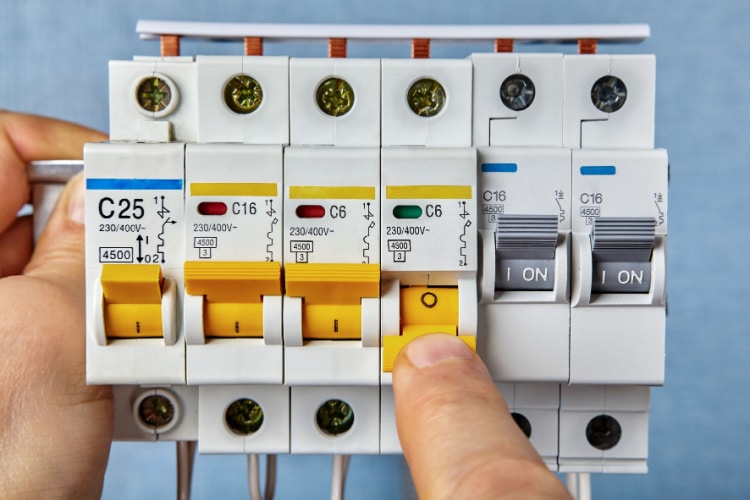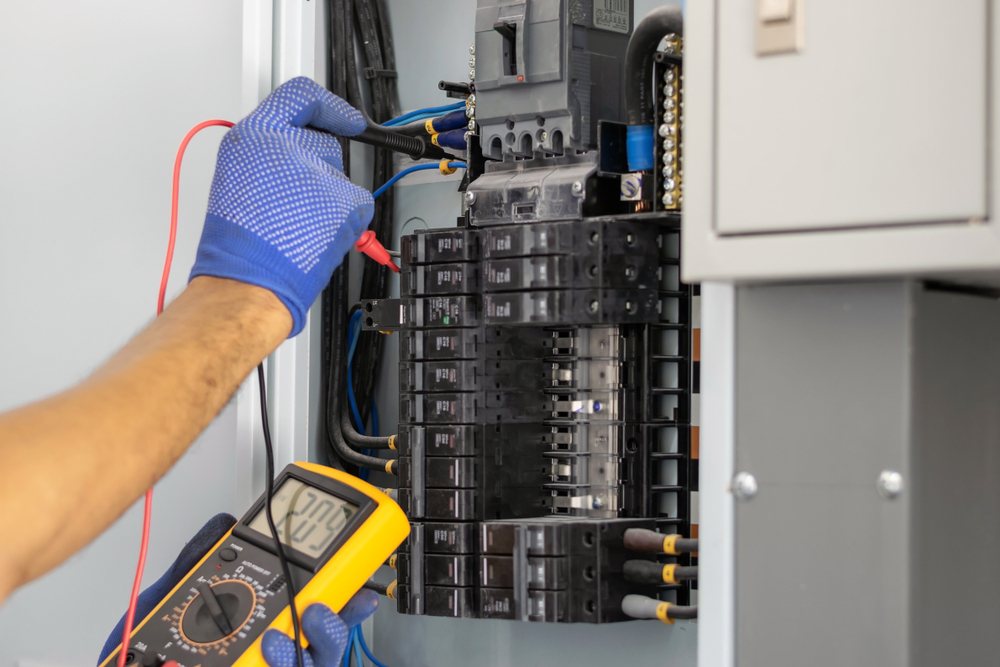When people say they have a bad circuit breaker, the top three things that come to mind are electrical overload, ground failure, or short circuits.
However, the reasons for circuit breakers failing are plenty, and knowing how each one impacts a breaker or contributes to its failure is time well spent.
This article will explain the purpose behind a circuit breaker and discuss the top 10 reasons it may go bad. Plus, we’ll share tips on what you can do in all of the scenarios we share
What is a Circuit Breaker and How Does It Work?
A circuit breaker protects the electrical system from electrical damage and potential electric fire. It does so by automatically switching off the flow of electricity to a circuit when it detects an excessive current flowing through it.

A circuit breaker comprises three main parts:
- A switch — used to turn the circuit breaker on and off
- A trip mechanism — shuts off or “trips” the breaker when an excessive current flows through the circuit
- A sensor — detects the current flowing through the circuit and sends a signal to the trip mechanism
Let’s explain how the three parts work.
When an excessive current flows through a circuit, the sensor detects it and transmits a signal to the trip mechanism. The trip mechanism then quickly flips the switch off, breaking the electrical connection and stopping the current flow through the circuit.
Circuit breakers are a mandatory component of electrical systems and are required by the National Electric Code (NEC). In addition to protecting our electrical system from damage, they also provide a convenient way to quickly turn off power to a circuit for maintenance or repairs.
They come in different sizes and types. For example, some circuit breakers are made for business or industrial use, while others are designed for households. Additionally, they come in various trip curves, defining the current the circuit breaker is capable of supporting before it trips.
Nevertheless, regardless of size or type, the reasons behind a failed circuit breaker are the same. Let’s see what they are.
Top 10 Reasons Why Circuit Breaker Goes Bad

Circuit breakers are prone to wear and tear over time, just like any other part of the electrical system.
There are 10 reasons why circuit breakers go bad.
1. The Circuit Breaker Has Reached the End of Its Lifespan
Circuit breakers have a finite lifetime, typically lasting 20 to 30 years. After this time, they may trip more frequently or fail to “break” when they should.
Fix: You must replace your circuit breaker to ensure the security of your electrical system. However, replacing a circuit breaker requires technical knowledge and expertise. If you’re not a professional, we recommend hiring a licensed electrician to replace it. They’ll have the knowledge and experience to ensure the replacement is done safely and correctly.
2. The Circuit Is Overloaded
Electric overload is one of the most common reasons why circuit breakers fail. It occurs when too much power is being drawn from the outlets, exceeding the capacity of the circuit.
Fix: Overloading the circuit breaker poses a serious problem and may damage your electrical system or even ignite an electrical fire. To fix an electric overload, follow these steps:
- Identify the source of the overload
- Disconnect the devices causing the overload
- Reset the circuit breaker
- Consider upgrading the circuit breaker to a higher amperage rating
3. Short Circuit
Circuit breakers also fail because of a short circuit. This issue occurs when a direct connection between the hot and neutral wires bypasses the load. For example, it may happen when wires are frayed or damaged or when two wires touch each other accidentally.
Fix: Here’s what you can do to fix a short circuit:
- Turn off the power supply
- Identify the source of the short circuit (damaged wire, a faulty switch, or a damaged appliance)
- Remove the faulty component
- Repair or replace the defective component
Note: If you are not confident you can handle the issue, we recommend employing a qualified technician.
4. Ground Fault
A ground fault on a circuit breaker happens when an electrical current is unintentionally diverted to the ground. For example, a ground fault results from direct contact of a live wire with a grounded object or a wire. Ground faults may lead to an electrical shock or even electrocution.
Fix: To repair a ground failure on a circuit breaker, follow these steps:
- Turn off the power supply
- Identify the source of the ground fault
- Inspect for damaged wiring
- If the circuit is protected by a GFCI (Ground Fault Circuit Interrupter), check to see if it has tripped
- Test the appliances for damage, unplug them all from the circuit, and test each one individually
- Repair or replace the faulty component
Note: If you’re not confident in your abilities or knowledge, we recommend employing a qualified technician to repair the ground fault.
5. Overheated Circuit Breaker
Circuit breakers are meant to trip when their temperature surpasses a certain threshold as a safety measure. And overheating may happen when there is a loose wire connection, or the circuit breaker is overloaded.
Fix: An overheated circuit breaker is a serious issue that could ignite an electrical fire. It’s crucial to act immediately if you notice an overheated circuit breaker. Here are the steps you can take to fix an overheated circuit breaker:
- Turn off the power supply
- Allow the circuit breaker to cool down
- Check for any signs of damage or corrosion
- Tighten loose wires
- Reduce the load on the circuit
6. Corrosion
Corrosion develops when air humidity or corrosive chemicals are present within the circuit breaker. It weakens the contacts inside it, so the breaker may trip when it shouldn’t or fail to trip when necessary.
Fix: Switch off the circuit breaker and remove it from your electrical panel. Use a wire brush or sandpaper to clean the corrosion. If it’s stubborn, you can use a mixture of baking soda and water to scrub the affected area. Once the circuit breaker is dry, clean, and corrosion-free, reinstall it in the panel. Make sure it’s appropriately seated before turning the power back on.
7. Improper Wiring
Improper wiring is when wires are not correctly secured, or the terminal screws are not tightened enough.
Fix: Locate the loose wires or terminal screws on the circuit breaker and secure them.
8. Mechanical Failure
Mechanical failure results from worn or damaged internal mechanisms of the circuit breaker. Such mechanical defects become common as the circuit ages or if it has manufacturing defects.
Fix: Depending on the circuit breaker type, the mechanical defect may include problems such as a fractured spring or a damaged trip component. We recommend consulting the circuit breaker’s user manual for more information on the particular issue.
Once you identify a damaged component, such as a spring, you must repair or replace it. Replacement components are usually available at a hardware shop or online. Always follow the manufacturer’s directions to replace the component or let a professional handle it.
9. The Circuit Has Suffered a Power Surge
A power spike happens when there is a rapid increase in voltage in the electrical system. It’s usually a result of lightning hits, power disruptions, electric overload, or defective machinery. Power spikes harm the electrical system, the plugged-in appliances, and the circuit breaker.
Fix: If your circuit breaker frequently suffers power surges, the best thing you can do to protect it is to install a whole-house surge protector. A whole-house surge protector shields the electrical spike and your circuit breaker, grounding the excess voltage that will otherwise damage your electrical system. Also, consider unplugging devices and appliances you aren’t using to not overload the circuit and cause a power surge.
10. You May Have a Poor-Quality Circuit Breaker
Finally, low-quality circuit breakers may fail more often. Circuit breakers of poor quality are typically unable to manage the electrical burden or fail to trip when required.
Fix: To guarantee the safety of your electrical system, use high-quality circuit breakers from respected manufacturers.
Some of the best circuit breakers that currently dominate the market are:
Conclusion
As you can see, there are many reasons why a circuit breaker goes bad.
The most common causes are an electric overload, short circuit, ground fault, or your circuit breaker simply might have reached the end of its lifetime.
Other possible reasons include an overheated circuit, corrosion, improper wiring, mechanical failure, a power surge, or a poor-quality model.
So, have you identified the cause of your bad circuit breaker? Whatever it may be, kudos to you because you now know how to resolve your issue!
Thank you,
I had a new home built in 2015 and my A/C Breaker went bad. It was not one of the top rated I guess, so disappointed.